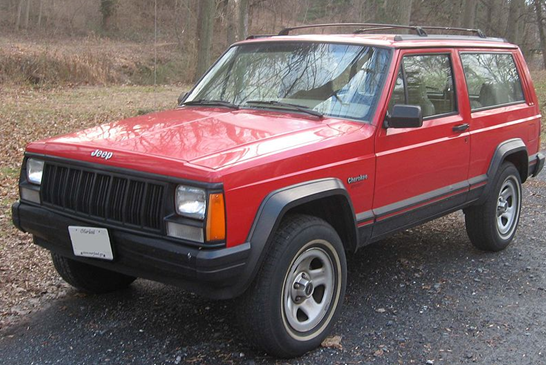Jeep Cherokee (XJ)
USINFO | 2013-04-28 13:15

The Jeep Cherokee (XJ) is a unibody (monocoque) compact SUV that was developed and produced by the Jeep division of American Motors, and continued to be built and marketed by Chrysler after 1987. It shared the name of the original full-size SJ model, but without a body-on-frame chassis, and set the stage for the modern sport utility vehicle (SUV). The XJ's innovative appearance and sales popularity spawned important imitators as other automakers began to notice that this model began replacing regular cars.[3] It was built in Toledo, Ohio, in Beijing, China, in Ferreyra, Argentina, and in Valencia, Venezuela. The XJ provided the mechanical basis for the MJ-series Jeep Comanche pickup truck.
The XJ Jeep has been described as one of the 20 greatest cars of all time, and "possibly the best SUV shape of all time, it is the paradigmatic model to which other designers have since aspired".
Due to its toughness and reliability, the XJ was also selected in 2011 as one of "10 cars that refuse to die" by Kiplinger.
Background
Designs of the compact-size XJ Cherokee date back to 1978 when a team of American Motors (AMC) and Renault engineers drew several sketches. Clay models were based on the then current full-size SJ Cherokee. Early sketches of the XJ Cherokee had a European influence, and most of the styling cues were done by AMC engineers under the direction of Richard A. Teague, Vice President of Design.
Noticing that General Motors was developing a new two-door S-10-based Blazer, AMC decided to develop an entirely new four-door model in addition to a two-door version. American Motors' Vice President of Engineering, Roy Lunn, designed what is known as the Quadra-Link suspension that limited rollovers.[6] Renault's François Castaing developed the drivetrain using a much smaller engine than normally found in 4WD vehicles and reduced the weight of the new model.[7] It is described "as the first small crossover SUV in the U.S.," with "plenty of the Jeep toughness (and a straight-6 engine) built in."
Although the XJ models were just introduced, AMC quickly began development its successor. To compete against its much larger rivals, the smallest U.S. automaker created a business process that is now known as product lifecycle management (PLM) to speed up its product development process.[8][9] By 1985, development and engineering was based on computer-aided design (CAD) software systems while new systems stored all drawings and documents in a central database.[8] The pioneering PLM was so effective that after Chrysler purchased AMC in 1987, it expanded the system throughout its own enterprise.
The compact Jeep was selected by Robert Cumberford of Automobile magazine as a "masterpiece" design and a paradigmatic model that was copied by other automakers.[4] It became "a perfect blend of sport and utility in a four-wheel-drive vehicle."
Share this page